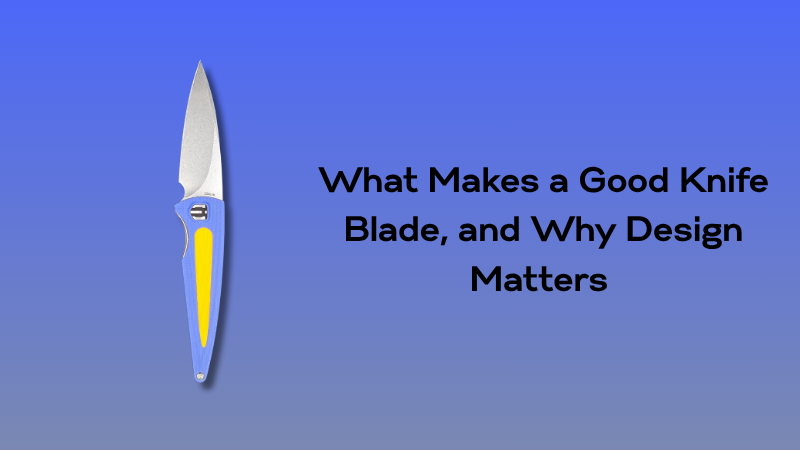
What Makes a Good Knife Blade, and Why Design Matters
Knives have always been more than just cutting tools — they’re reflections
of design, functionality, and human ingenuity. Whether it’s a chef’s blade, a
survival knife, or a collectible Pocket knife, the craftsmanship behind each one is what defines its
quality. But what makes a knife blade truly good? And why does the design of
that blade matter so much?
In this article, we’ll explore what defines a well-made knife blade, break
down popular blade types, and explain why form and function go hand-in-hand.
Whether you’re a casual buyer, an outdoor enthusiast, or a collector of premium
knives like the Shieldon knife, understanding blade design is key to choosing
the right tool.

Why Knife Blade Design Matters
Just like a car, a knife blends aesthetics and utility. A well-designed
knife isn't just sharp — it’s also reliable, comfortable, and purpose-driven.
Whether you’re slicing rope, skinning game, or prepping a campsite meal, the
blade design should match the task.
Structure and Balance
A well-designed knife begins with structure. The shape and build of the
blade must support its intended use. For example, a heavy-duty Folding Knife
for outdoor survival must be strong enough to handle tough materials without
snapping or bending.
A balanced knife feels stable in your hand. The weight distribution
between the blade and the handle matters, especially during long or repetitive
use. Comfort also plays a role — ergonomic grips, grooved textures, and finger
guards prevent accidents and improve control.
Function and Aesthetics
A knife’s appearance often gives away its purpose. A Martial Arts knife
might have a sleek, tactical profile with a spear-point or tanto blade. On the
other hand, a drop-point blade on an EDC knife is built for everyday
tasks like slicing, opening boxes, or food prep.
From practical utility to visual appeal, the design defines how the blade
performs — and how it looks doing it.
Popular Knife Blade Types and Their Functions
With so many blade styles available, understanding their unique features
can help you choose the right knife for your needs. Below are the most common
and effective designs in today’s market.
Drop-Point Blade
One of the most versatile designs, drop-point blades feature a convex
spine that gently curves down toward the tip. This style offers a broad cutting
belly and a strong tip, making it ideal for slicing and controlled cutting.
You'll often find this blade type on Pocket knives used for
camping, hunting, or multitasking.
Clip-Point Blade
The clip-point blade has a section of the spine "clipped" off,
creating a narrow, sharp tip. It's perfect for precision work and detailed
cuts. Lightweight and nimble, it’s a common blade in smaller Folding Knives.
However, its thinner tip is more fragile compared to drop-point styles.
Sheepsfoot Blade
Originally designed for trimming sheep hooves, this blade has a straight
edge and a rounded, sloping spine. It prevents accidental piercing, making it
ideal for controlled slicing.
This design is often favored in rescue and safety knives due to its
user-friendly profile.
Straight Back Blade
The classic straight back blade is flat along the spine and slightly
curved on the cutting edge. It's usually found on fixed-blade models meant for
heavy-duty tasks like chopping, slicing, and bushcraft.
Paired with a long handle, this type delivers powerful leverage,
especially useful in the outdoors.
Tanto Blade
Inspired by traditional Japanese samurai swords, the tanto blade features
a chisel-like edge that sharply angles to a pointed tip. Designed for piercing
tough materials, it’s popular in combat and Martial Arts knife styles.
Tanto blades are known for their strength at the tip and aggressive
appearance — a favorite among tactical users.
Gut Hook Blade
The gut hook is a specialty blade with a small, sharpened hook on the
spine near the tip. It’s mainly used for field dressing game, allowing hunters
to open up skin without puncturing internal organs.
This blade type is usually paired with a sturdy, grippy handle to avoid
slips in messy conditions.
Hawkbill Blade
This blade curves downward like a hawk’s talon, providing excellent
pull-cut power. It’s especially useful in industrial applications — from cutting
carpet and rope to slicing linoleum.
Its fixed curved shape ensures that the blade remains in contact with the
material throughout the cut.
Spear-Point Blade
Symmetrical with a centered tip, spear-point blades are often double-edged
and built for thrusting. Their compact size and central balance make them ideal
for self-defense, throwing, and tactical work — but they are restricted in some
regions due to their combat potential.

What Materials Make a Blade “Good”?
Design is only half the story — material choice impacts sharpness,
durability, and ease of maintenance.
- Stainless
Steel: Resists rust and
corrosion. Common in EDC knives and beginner models.
- Carbon Steel: Offers sharper edges and better retention but
needs more care.
- Damascus
Steel: Beautiful, layered
material with excellent toughness and flexibility.
- Titanium: Lightweight, strong, and corrosion-resistant —
often found in premium knives like a top-tier Shieldon knife.
The right material depends on your use case: everyday convenience, rugged
wilderness, or collectible value.

Takeaways
A great knife doesn’t happen by accident. It’s the result of thoughtful
design, smart material selection, and manufacturing excellence. Whether you're
using a Pocket knife to prep food, a Folding Knife to open packages,
or a Martial
Arts knife for specialized
training, blade design defines your experience.
At Shieldon, we take all of these principles seriously. Our blades
are engineered for precision, comfort, and real-world performance — combining
tradition with modern tech to serve everyone from beginners to seasoned
collectors.
Visit Shieldon today to explore our full line of expertly crafted knives
and learn more about the science and style behind every blade.
